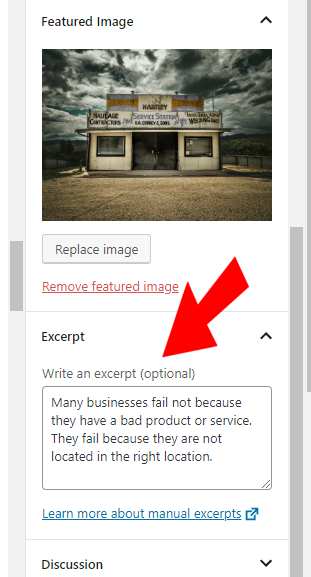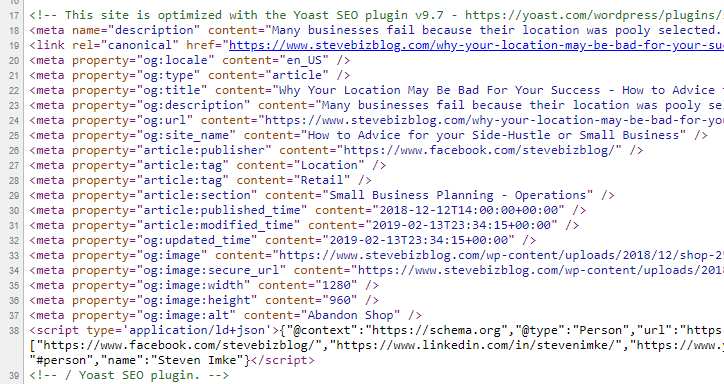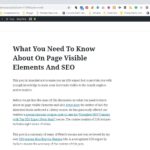SEO is a buzzword with many freelancers and companies selling you their service. Many claim that they can make your business appear on page one of Google. However, the key that is often overlooked in this initial discussion is if they can get you ranked for a popular keyword that is relevant to your business.
It is one thing to get ranked by the search engines on page one for some nonsensical term, but quite another to get ranked for a keyword that is associated with what your business does.
What I have discovered is that there are many freelancers that claim to be an expert in SEO, but far fewer are what I would call real experts. Most understand the basics of SEO and will sell you a bill of goods based on false claims. Many freelancers and even many SEO companies can get away with it because most customers don’t speak the language of SEO, and are forced to rely on the advice from their SEO consultant.
Related: How To Know If You’ve Got a Legitimate SEO Company
This post is intended not to make you an SEO expert, but to provide you with enough ammunition where you can at least have an intelligent conversation about SEO. This knowledge will help you discover which SEO freelancers or SEO companies are the real deal and which are the posers.
What is SEO?
SEO is primarily about getting the search engines to recognize your content so that they can return a contextually accurate result for a search. The way this is done is through the search engine’s understanding of your Keywords learned through their indexing process. When we talk about on-page but hidden SEO techniques, we are talking about all the clues you can provide the search engines to tell them about your content.
URL Clues for SEO
One way to let search engines know what a page is about is through the use of your URL. If your URL is GardeningTipsByBob.com, the search engine can infer that the content must be about gardening. If you have landing pages and you place them in a directory on your domain, the directory and the filename are used by search engines to uncover even more about what the content is.
GardeningTipsByBob.com/Flowers/Full-Sun/Wild-Daffodil.html
Using a hierarchy of folders allows you to enter keywords into the actual URL. The search engines will assume that the above content is about tips to grow flowers, in particular, ones that require full sun, and even more specifically how to grow wild daffodils.
If a folder or a file name is a multi-word keyword, use a dash “-“ to separate the words and DO NOT leave a space or use an underscore. Search engines like Google see a dash as a word separator. In fact, Google specifically recommends that you use a dash and not an underscore.
However, do not include lots and lots of folders to keyword-stuff your URL or Google will see past this effort to game its algorithm and penalize you.
By default, a Content Management System like WordPress often uses folders for year, month, and day. This is good for sorting content based on when it was created, but not very helpful for SEO. You can Google “URL Rewriting” to find tools that will help you change the URL or Permalink of your content.
Title Tag Clues
When you are writing a post, you will provide a title for your piece which your Content Management System will format into your Title Tag. It is best to limit the size of your title to about 50-60 characters. In fact, in the search results, only the first 50 to 60 characters are displayed, while longer titles are truncated.
Google also weighs the words at the front of the Title Tag more than at the end, so be sure to use your keywords at the beginning of a title. By placing your keywords closer to the front of your title, it is also more likely to be read by the user in the search results.
It is recommended to use title case, which is where the first letter of each principal word is an upper-case character because title case has been proven to be easier to read and make the principle words pop out.
Keyword Meta Tag – Not Worth It Anymore
In the old days, search engines used to determine what the page was about by looking at the Keyword Meta Tag. However, web developers abused this and most SEO experts believe that search engines no longer give any weight to Keyword Meta Tags. Therefore, today it is recommended by many SEO experts to not waste your time with them.
Description Meta Tag – Your Call To Action
Search engines do not use the Description Meta Tag to rank a page, but it should not be ignored because it acts as a call to action to get the user to click on the link. By default, search engines will use the first 160 characters in the body text to populate the description. However, it is better if you populate the Description Meta Tag with the content you want to appear in the search results.
If you use the Yoast SEO plugin, you can use the “Edit Snippet” to enter your description text for the Description Meta Tag.

If you don’t use Yoast and are just using WordPress for example, the “Excerpt” text you provide will be used as the Description Meta Tag.

While a description can be much longer, Google will truncate any text over 160 characters. In many cases, Google will also add a date at the beginning of the description in its search results, which will count toward the 160 characters. It is recommended that your text in the Description Meta Tag be shorter than 160 characters. When you edit the Snippet in Yoast SEO, the results are calibrated to show you when you exceed the 160-character Google limit, however, it does not take into account the size of the date if added by the search engine.
While a search engine will not use the text in the Description Meta Tag to rank the page, it is recommended that you use your keywords in it, because Google will highlight the keywords in the description which will make them stand out to the reader. The following is a search result when I entered “category of adopters” into Google. As you can see the words I typed appear bolded in the description text.

Pro Tip: When you write your Description Meta Tag, it is recommended by the experts that you use title case and not sentence case, as title case has been proven to be easier to read when scanning. When you have a word that you want to draw to the reader’s eye, you should consider using all upper case to draw the eye to these words- but don’t over do it.
Given the character limits, it is not necessary that your Description Meta Tags be written in complete sentences. It is recommended that you write them using snippets of text to make better use of the limited space.
Other Meta Tags For SEO
For the experts, there are a bunch of other tags, but the above are the key ones. The majority of the other meta tags as used to pass information to platforms like Facebook and Twitter.

How can you better use the on-page but hidden SEO Techniques to help search engines understand and display your search results?
Peter Kent, the author of the book “SEO for Dummies” also has a Udemy course. Peter has graciously offered our readers a special discount coupon code to take his “Complete SEO Training with Top SEP Expert Peter Kent” course. The course consists of 158 lectures and includes eight hours of video.
This post is a summary of many of Peter’s lessons and was reviewed by my own SEO maven Miss Bhavya Sharma, a recognized SEO expert in India, to ensure the accuracy of the content of this post.
Related Post in SEO Series:
- Keywords-Everything You Wanted to Know But Were Afraid to Ask
- 20 Steps to Find Powerful Keywords Google will Rank High
- On-Page But Hidden SEO Techniques You Need To Understand
- What You Need To Know About On-Page Visible Elements And SEO
- What you Need to Know About Link Building
- What You Need to Know About a Backlinks and SEO
- How To Find The Best Performing Keywords And Rank Higher In SERP
- How Your SEO Actions Expose You As A Cheater Or A Star












